#Home Automation Pittsburgh
Text
Synergies Between Home Automation and Security Systems
How can convenience and peace of mind be guaranteed through the seamless integration of home automation and home security systems? Our homes are becoming smarter in today's rapidly changing world, offering a variety of interconnected technologies that improve our comfort, convenience, and security.

(Source: https://www.grandviewresearch.com/industry-analysis/smart-home-automation-market)
As homeowners in the US increasingly seek comprehensive protection while enjoying the benefits of automated living, the potential synergies between security and home automation in Pittsburgh become an intriguing topic of exploration.
Exploring The Overlapping Domains: Where Automation Meets Security
In today's world, the merging of home automation and security systems opens up exciting possibilities. With the use of advanced technologies like facial recognition and biometric authentication, security systems have become smarter and more efficient in protecting our homes.
The convergence of automation and security creates a synergy that benefits homeowners in several ways:
Enhanced Security Measures
Integration of security cameras with automation enables real-time monitoring and remote access to video feeds.
Motion sensors integrated with automation can trigger alerts, activate lighting, or adjust temperature settings in response to detected activity.
Smart locks and access control systems can be seamlessly integrated with automation, allowing convenient and secure entry.
Automated Responses
Automation systems can be programmed to respond to specific security events automatically, such as locking doors, activating alarms, or notifying authorities.
In case of emergencies like fire or gas leaks, automation can trigger immediate actions, such as turning off appliances and notifying homeowners.
Peace of Mind
The ability to remotely monitor security cameras and receive real-time alerts through automation provides homeowners with peace of mind even when they are away.
Integration of automation and security systems allows homeowners to create custom scenarios, such as simulating occupancy when on vacation, enhancing the perception of a secure and inhabited home.
Importance Of Consulting A Professional For Home Automation
Consulting a professional for home automation is essential to ensure a smooth and effective implementation. Here's why it's important:
A professional surveillance camera installer possesses the technical knowledge and experience to install, integrate, and configure automation systems correctly, maximizing their performance.
Experts in the field can assess your unique requirements and recommend tailored automation solutions that suit your lifestyle, preferences, and budget.
Best service providers understand how to integrate different automation components seamlessly, ensuring compatibility and a cohesive user experience.
Most professionals offer ongoing support, troubleshooting, and assistance, ensuring your automation system functions optimally and addressing any issues promptly.
A professional security camera installer prioritizes the safety and security of your home, implementing robust protocols to protect your privacy and safeguard against potential vulnerabilities.
Final Words
By consulting a professional for home automation, you can benefit from their expertise, ensuring a reliable and efficient automation system that enhances your daily life while providing peace of mind.
Now, are you looking for a network cabling installation service or an ethernet cable installer in Pittsburgh for home automation with reliable network infrastructure? Look no further than Red Spark Technology. With competitive prices and a team of experts, they have got you covered. Reach out to the professionals at Red Spark Technology today for more information!
Source: https://redsparktechnology.wordpress.com/2023/07/31/synergies-between-home-automation-and-security-systems/
0 notes
Text



"Herbert" Televox by Roy James Wensley (1927), Westinghouse Electric and Manufacturing Company, Pittsburgh. Televox is not actually a mobile robot, as you may have already guessed from the photos, but a sophisticated smarthome automation system. You phone home in the usual way and then use tuned pitch pipes or electric tuning forks to sound different tones down the line. Televox uses different tone sequences to switch different items of equipment on and off. Televox can also provide audio responses to tell you the status of home sensors, so it can tell you if your heating is up to temperature. Televox was housed in a large upright box, with a small box on top, which looks a little bit like a body with a head; so on 23 Oct 1927, the New York Times ran an article with a robot-like cartoon of these boxes, as a way to explain the capabilities of Televox, because the Internet of Things hadn't been invented yet. The version we see with the cut-out human form (with Wensley to the left) was made for George Washington's birthday, on 22nd Feb 1928, and Westinghouse marketing loved it so much that a number of 'humanoid' Televox units were demoed across the country. If you look closely, you can almost see Wensley dying inside.
31 notes
·
View notes
Photo









A Visit to the Ohio River Museum’s W.P. Snyder, Jr., Marietta, Ohio.
“Hey, Atlas Obscura, I’m heading south-east through Ohio toward West Virginia; what can I stop and look at along the way?”
Or some such thought was in mind as I “prepared” to drive off to Thurmond, WV, for another visit to that “ghost town” in the New River Gorge. There were a few places that I considered, but they were well off that north-west-to-south-east track that I wanted (too far to the north-east or south-west). Also well off of U.S. 35 that I would be traveling but still in the right direction was the Ohio River Museum, in Marietta, OH, and it’s major holding, the steam-powered towboat W.P. Snyder, Jr. It was the boat that got my attention.
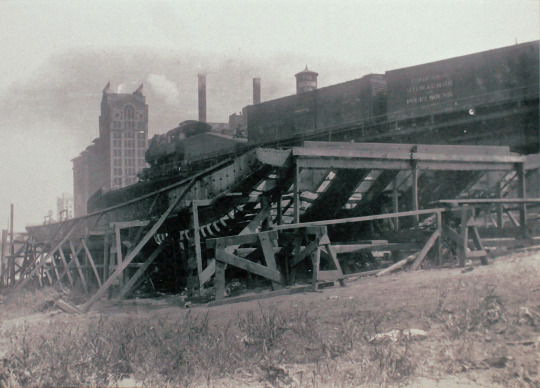

Two views of the steamer under construction in Pittsburgh. [1]
Built for Carnegie Steel, it was delivered in 1918 for barge work on the Monongahela and Ohio rivers as the W.H. Clingerman, in which service it operated until 1945, when the Crucible Steel Co. bought it; it was then renamed after that company’s chairman.
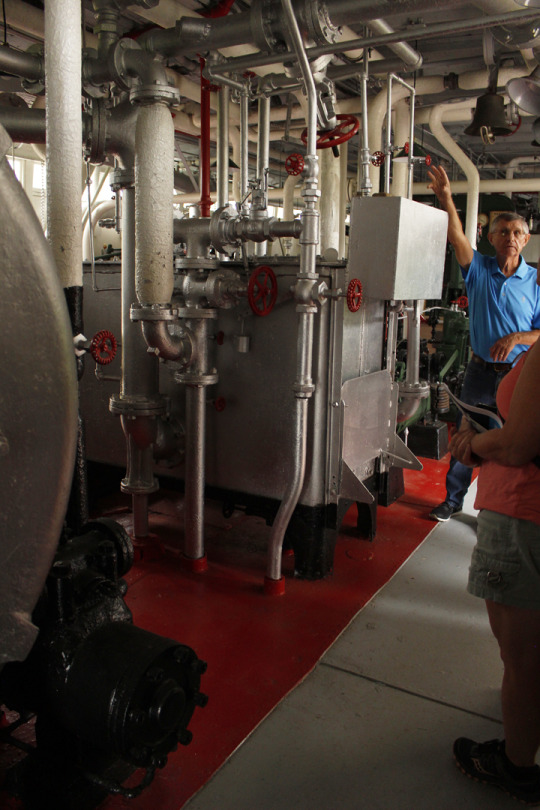
Alan, one of the museum’s volunteer tour leaders, indicating salient parts in the engineering room.
The Ohio, Allegheny, and Monongahela Rivers all have a number of lock-and-dam constructions up and down their lengths through the old-line industrial region, which create “pools” to aid navigation and to alleviate flooding (when possible). The boats built to work the rivers were constructed especially to fit within the locks, had their pilot houses situated at the fore-end of the boiler deck (to allow passage under low bridges), and were called “pool boats.” The Snyder was one of hundreds built to service the coal and steel businesses during the hey-day of “Big Steel,” but is today the last, still-floating, steam-fired, stern-wheeled pool boat. Sadly, it’s not likely to ever pull off the riverbank under its own power again (I asked).

Parts bins and condensers at the forward bulkhead in the engineering room.
The Snyder (or Clingerman) was state-of-the-art for 1918: it had electric lighting, power aided-steering, a full kitchen (with walk-in refrigerator!), a shower for the crew, a bathtub for the maid (yes, a woman), a full laundry, and featured automated “fuel augers” to shove coal into the boiler fire boxes. Alan, our tour leader, told us that it was actually fairly common by the early 20th century for there to be a woman working as a maid, and not uncommon for her to be wife to one of the higher-rated crew, like the chief engineer.
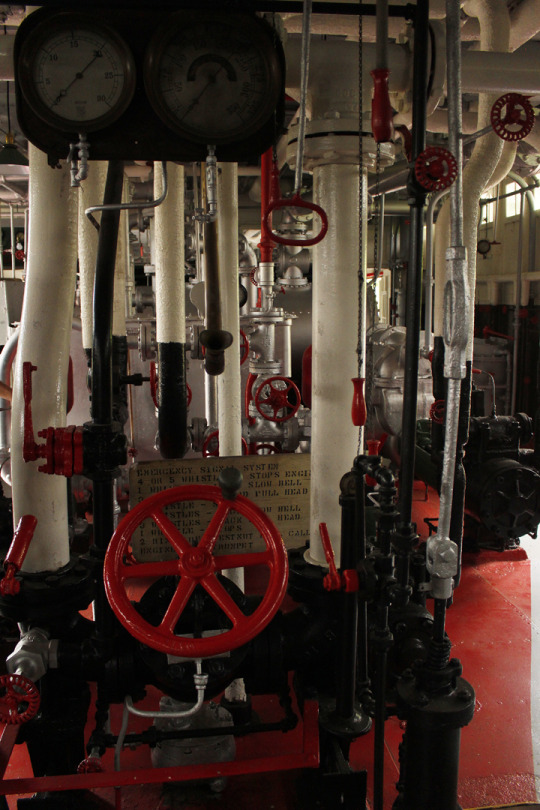
Looking forward through the maze of piping in engineering.
The steam powered pool boats were put out of work by newer, diesel powered boats that were being launched in the late 1930 and in the ‘50s. Needing smaller crews and less maintenance (much like the difference between steam locomotives and diesels on rail roads) the steamers were retired and scrapped. The Snyder was retired in ‘54, but someone had the bright idea to save it; it was moved to Marietta in ‘55 and permanently moored.

Typical double-bunk crew room. Doors to both the central passageway and to the outside were included to make escape easier in case of fire. The Snyder has enough double-bunk rooms to allow each crewman to have his own bed instead of sleeping in a “hot sheet” arrangement. The maid had her own bunk room and wash room.

Galley (kitchen) with a very large coffee pot on the coal stove; the walk-in cooler or refrigerator is to the right-back, with the heavy hinges and pivot lock that were features of the (much smaller) in-home ice boxes of the era.

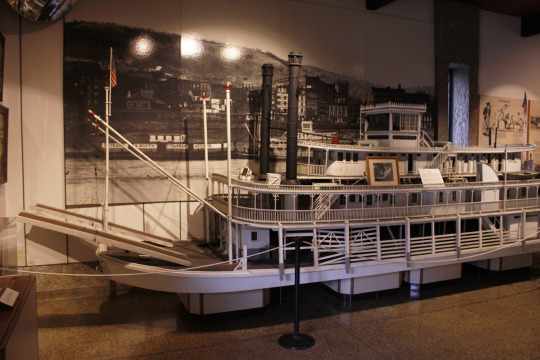
Contrasting details: though only a (very large) model, this packet boat inside the museum shows the kind of steam boat that would be typical of the Mississippi River’s steam boating era, and an example of the steamer commonly held in popular imagination. [2] Rivers steamers were considerably longer and higher in profile than pool boats, and carried cargo and passengers, while pool boats just did the barge work.

The Clingerman under way in 1930. [1]
Photos: R. Jake Wood, 2021 except as noted.
Ohio River Museum
Atlas Obscura
[1] Photos as displayed in the Museum; no specific attribution; minor processing for perspective and exposure by Jake Wood.
[2] Steamboat model Pioneer built by George Schotten, circa 1970; a fully detailed, if reduced scale, boat, the Pioneer was capable of being floated and piloted in a river.

Postcard shot! Literally, a picture postcard of the Snyder by S. Durward Hoag.
1 note
·
View note
Photo
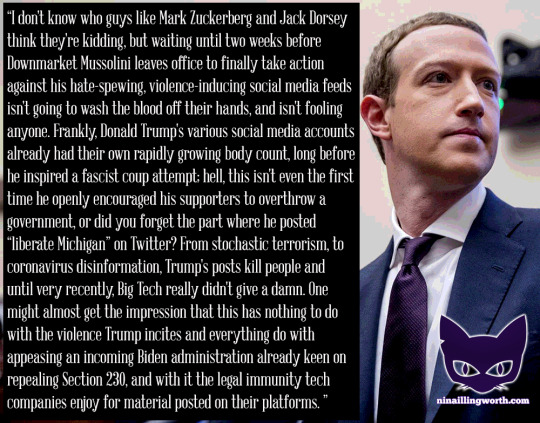
Author’s note: as an independent, anarcho-syndicalist analyst who currently doesn’t even have a Twitter account, my ability to do the work I do online hinges on word-of-mouth referrals and recommendations; if you like this article, please share a link to it someplace else on social media.
The Trump Suspensions, Big Tech and Section 230
If the truth is to be told, I've spent the better part of the past week and a half trying to put Trump and his coup attempt behind me; with a hyper-capitalist Biden administration on tap, and already trafficking in austerity mythology and neoliberal authoritarianism, my internal analyst's relevancy clock is ticking like a time bomb. Furthermore, I believe that the fallout from the actual chud insurrection on January 6th, has finally rendered Trump himself an impotent, and increasingly less relevant, figure in what I have repeatedly predicted will be an ongoing American fascist movement. Finally of course, after five years of writing “yes, this guy is literally a fascist” over and over, I've grown extremely weary of arguing about what fascism is, and isn't, with contrarian left types who don't realize they're still operating under the hypnotic spell of American exceptionalism.
Unsurprisingly however, the news itself hasn't really given a damn what I'd rather be analyzing, and the fallout from the chud riot in D.C., has utterly dominated the coverage and discourse; creating infuriating and irresponsible narratives about what is ultimately a clear cut act of politicized violence by far right, fascist extremists. Recently, I've been offering a lot of push-back on narratives popular among the more reactionary elements of the online “left,” but today I'd like to turn our attention to a popular “neoliberal” (but not necessarily Democratic Party) narrative being pushed by elite capital, and the cluster of companies we collectively know as Big Tech. Namely, the idea that in the wake of the coup attempt, billion dollar social media companies should be lauded for finally suspending the accounts of Donald Trump and thousands of his fascist cronies, on their various services.
Now, don't get me wrong here; this isn't going to be a rant about censorship, and I personally think it's an unquestionably good thing that Trump (and fascist organizers) have been driven off social media, but something smells like rotting fish in all this, and I'm sure you won't be surprised to learn that greedy, crypto-reactionary Tech Bros running billion dollar social media companies, are at the heart of it. To understand my problem here however, the first thing we have to ask is “why was Trump suspended from social media?”
Obviously each of the various social media companies have released statements about their decisions, but we're not really here to waste our time dissecting what amounts to public relations and propaganda. On an extremely basic level, most people understand that Trump's accounts were suspended for using election fraud conspiracy theories to ultimately incite fascist violence, and inspire a chud insurrection that left five people dead. Reduced to its essence, this then leaves us with three major “justifications” for the Trump suspensions; spreading dangerous conspiracy theories, inciting an insurrection, and inspiring (lethal) violence – all very good reasons to suspend someone's Twitter or Facebook account, wouldn't you say?
Unfortunately for guys like Mark Zuckerberg and Jack Dorsey however, there are in fact some obvious problems with this narrative no matter which angle you choose to approach it from; let's start with the fact that Trump's social media feeds have been creating dead bodies and inspiring reactionary violence for years. It is no great secret that racialized violence and hate crimes have risen drastically in America (and the larger Pig Empire) since Trump launched his first election campaign with an explicitly fascist speech about Mexicans and migrants. What is far less often discussed however, even on ostensibly “liberal” news networks, is the ways in which Trump (and his tweets) have already directly inspired violence and murder in America and even abroad:
In addition to the surging national hate crime figures, a May 2020 investigation turned up at least “54 criminal cases where Trump was invoked in direct connection with violent acts, threats of violence or allegations of assault.” As ABC notes, “the cases are remarkable in that a link to the president is captured in court documents and police statements, under the penalty of perjury or contempt. These links are not speculative – they are documented in official records. And in the majority of cases identified by ABC News, it was perpetrators themselves who invoked the president in connection with their case, not anyone else.”
At least three different mass shooters (Pittsburgh, El Paso, Christchurch New Zealand) can convincingly be said to be have been inspired by Trump, or Trump’s rhetoric in some direct and observable way. Their total body count is eighty-four dead people who would likely still be breathing today, if Donald Trump had never logged on to social media or been given a platform to spread hatred and fascist ideology.
All of this is of course to say nothing of Trump’s peripheral involvement with and support for other groups responsible for right wing violence, like the Q-Anon conspiracy movement, or the neo-Nazi rioters who tore up Charlottesville and murdered Heather Heyer.
Naturally then, the obvious question becomes, if Trump was suspended for inciting deadly violence on January 6th in D.C., why wasn't he suspended for doing exactly the same thing before now? Hell, I'll do you one better; if Trump is suspended for inciting reactionary violence and murder, then why aren't guys like fascist provocateur Andy Ngo, and Wilks Brothers muppet Ben Shapiro (who himself has inspired an international body count) also suspended? Right, it simply doesn't track, and therefore we can conclude that Trump's social media suspensions really didn't have anything to do with inciting violence.
Alright, so be it, maybe you personally agree that “inspiring deadly violence and hate crimes” is somehow a loose reason to suspend a guy's social media accounts, whether he's president or not. Maybe, you figure that where Trump really crossed the line was purposely inciting a goddamn insurrection, and you're happy that Big Tech corporations understand the fine line between fascist murders and fascist terrorism. Unfortunately, that narrative doesn't track either because this isn't the first time Trump has tried to inspire an insurrection on Twitter; please recall the partially-AstroTurfed “Anti-Lockdown protests” in the spring, and in particular Trump's attempts to inspire an uprising in my home state of Michigan. Do you remember the “Liberate Michigan” tweet? The armed fascist militias occupying the Michigan legislature? The chud plot to kidnap and perhaps kill, the Governor of Michigan? Would it surprise you to learn that many of the same people who participated in those prior chud protests were part of the crowd that stormed Capitol Hill on January 6th? Is Jack Dorsey really arguing that Trump's insurrectionist tweets in the spring were fine, but his insurrectionist tweets in January are not because... more people saw the later on TV? Say what?
All of which of course brings us to the somewhat nebulous, “dangerous conspiracy theories” portion of the rationale for suspending Trump now, in the wake of the chud uprising. It's not much of a leg to stand on either however, because not only has Trump been pushing election fraud conspiracy theories for the past freaking year, but that isn't even the most dangerous and deadly example of his false reality narrative causing carnage in our society. You can take your pick, but I'd wager that both the Q-Anon conspiracy movement Trump has openly supported on social media, and the unhinged coronavirus conspiracies he propagated online for months and months, have much higher body counts than anything we saw on Capitol Hill. Why should anyone believe Big Tech companies care about conspiracy theories and how many people they kill, given their prior behavior up to this point? Please keep in mind that these are the same companies that decided not to suspend Trump's accounts when he was using them to threaten North Korea with annihilation; an act that could have easily lead to a catastrophic nuclear exchange if Kim Jong Un were half as un-moored from reality as our CIA-loyal media likes to imply.
Given all that then, what is the real reason behind suspending Trump's social media accounts? Again, it’s not that I'm concerned that a flatulent billionaire fascist manbaby lost some of his favorite outlets to spread fascist conspiracy theories, but why now, and not then?
To understand that, we're going to have to take a little bit of a detour here and talk about Section 230. What is Section 230? A portion of the American law that governs the internet, which ultimately indemnifies social media companies from legal liability for the crap other people post on their platforms. Without Section 230, victims of fascist violence organized on Facebook, could conceivably sue the pants off Big Tech companies for allowing that to happen. This is of course an existential crisis to gigantic tech firms that rely heavily on wildly unpredictable algorithms and automated processes to avoid having to hire moderators and actually keep an eye on what users are doing with their platforms. Furthermore, in the lead up to the 2020 election, both Joe Biden and Donald Trump talked about repealing Section 230, for (and this is key here) entirely different reasons.
Trump and his numerous allies in the Republican Party spent much of 2020 using the threat of repealing Section 230 as a cudgel against social media companies taking even mild action to combat these same dangerous conspiracy theories, and the spread of fascist ideology online. The GOP argument, disingenuously presented as a defense of free speech, was then that if Big Tech didn't let the fascists say whatever they wanted, regardless of its veracity or the potential consequences, they would open up companies like Twitter and Facebook to American libel laws. Of course, that's pretty laughable if we're talking about someone like Laura Loomer suing Twitter over her account being suspended, but Big Tech companies only have to look as far as Peter Theil's ultimately successful quest to destroy Gawker to realize it only takes one reactionary judge in a high enough chair, to sink their battleships entirely. Obviously then, you don't really need to be a genius to figure out Big Tech companies weren't excited about the idea of suspending Trump or his followers, because that would presumably result in an all-out assault on Section 230 from the sitting President of the United States and his (still quite influential) political party.
Ok, so great news for the Tech Bros right? Biden won after all, and barring a chud uprising on a scale not even I think they're capable of, he's about to become POTUS. Not so fast, because Biden and the so-called “centrist” neoliberal establishment in the Democratic Party are also threatening to repeal Section 230 for their own political advantage. The neoliberals too are disingenuously hiding their motives, this time behind a desire to combat hate speech and disinformation; truly noble goals, but obviously utterly irrelevant to rich white liberals who've spent the past five years conflating both Russian spies, and murderous fascist thugs, with leftists who want healthcare. Truthfully, this entire maneuver ultimately represents a ruling class, liberal elite attempt to arbitrate what is and isn't considered true, or newsworthy in the public discourse; a quest they've been furiously working on since the first Bernie Sanders political insurgency threatened to topple Democratic Party leadership, and naturally, throughout the bogus Russigate fever dream that dominated the first two years of Trump's presidency. Of course, even after Biden won the election, there really wasn't much reason for Big Tech companies to take this threat seriously; clearly the Republican Senate wasn't going to allow elite liberal censors to use a potential Section 230 repeal to dictate who can say what online, right?
Yeah, about that Republican Senate majority though; whoops. What if I told you then that the decision to suspend Trump's social media accounts sooner or later, was largely a forgone conclusion after the events of January 5th, not January 6th, 2021? What happened on January 5th? Joe Biden and the Democratic Party swept the Georgia special elections, effectively taking control of the American Senate, and putting folks like Zuck and Dorsey squarely in Biden's line of fire going forward.
Thus it can be said that the answer to both of our questions, “why wasn't Trump suspended before,” and “why is Trump suspended now” ultimately come down to who wields power in our society and our old nemesis, the profit motive. Companies like Twitter and Facebook don't really give a damn about disinformation, conspiracy theories or even Tweets that rack up their own body counts; what they care about is maintaining the warm embrace of legal impunity their business model depends on, and they'll do anything, to appease anyone with the power to remove that embrace, if they think it'll keep the gravy train going. Big Tech isn't fighting fascism, it's fighting oversight and the tyranny of having to pay live human moderators; there's nothing noble or praiseworthy about that, even if I'm still forced to admit that the censored neoliberal authoritarian alternative would be no better, and might be quite a damn sight worse.
Come meet the new boss; same as the old boss, indeed.
- nina illingworth
Independent writer, critic and analyst with a left focus. Please help me fight corporate censorship by sharing my articles with your friends online!
You can find my work at ninaillingworth.com, Can’t You Read, Media Madness and my Patreon Blog
Updates available on Instagram, Mastodon and Facebook. Podcast at “No Fugazi” on Soundcloud.
Inquiries and requests to speak to the manager @ASNinaWrites
Chat with fellow readers online at Anarcho Nina Writes on Discord!
“It’s ok Willie; swing heil, swing heil…”
#Trump#Twitter#Facebook#Social Media#Politics#Biden#Section 230#Censorship#GOP#Democrats#Chud Riot#Jan 6th insurrection#Georgia Special Election#Democrats control Senate#Mark Zuckerberg#Jack Dorsey#Trump Twitter Suspension#Anti Lockdown Protests#violence#Fascism#Terrorism#Amerikan Music#Free Speech
1 note
·
View note
Text
Akeptus
Address: Pittsburgh, PA 16046
Phone: 202-991-1826
Website: https://www.akeptus.com
Business email: [email protected]
Akeptus is your partner for change. We use the power of Artificial Intelligence (AI) to help you lower your monthly bills and protect the planet through lower carbon emissions. Our affordable and easy-to-use smart system allows you to control your lighting, water, heat and cooling usage while it learns what your most comfortable settings are.
Keywords: smart cities, smart home automation, home automation, automation for homes, smart building, clean tech, smart thermostat, smart lights
Hours: Mon - Fri: 8 am - 5 pm, Sat: 8 am - 1pm
Facebook: https://www.facebook.com/akeptus
Twitter: https://twitter.com/akeptus
Instagram: https://www.instagram.com/akeptus/
Linked-in: https://www.linkedin.com/company/akeptus
1 note
·
View note
Note
Hi!!! Are there any upcoming fics you’re planning and if so I’d love to hear about them 💕🍀
Oh goodness! This is a great question. My WIP list is really long since I write pretty slowly (or really, I write pretty fast when I actually do it, but tend to spend more time editing or daydreaming about writing then writing). But these are the ones I think I will actually finish:
1. Probably the next thing I will finish is a Klaus & Lemony thing to kind of go with the Violet & Lemony and Sunny & Lemony thing. It’s about half written and focuses on how they are super awkward together. I don’t know why, but that’s what worked. It’s also about Lemony spying on the Baudelaire’s, what Klaus thinks of Lemony’s books, and Lemony giving Klaus the pictures of him and Beatrice and Bertrand from Lemony and Beatrice’s engagement party. But it may be about something else by the time it’s done. I’ve changed my mind about this fic so many of times already.
2. I really want to write Lemony and Moxie getting back together (as friends--I don’t think there is really a phrase for that) after not talking for at least a decade after atwq. Just based on how that ended, Moxie needs to do a lot of soul searching, and things would need to change quite a bit before she wanted to pick that friendship back up. I think Lemony really hurt her. I have like.. two paragraphs written.
3. Based on a misremembering of what happens in TSS, I started writing fic about Lemony and Olaf meeting up in the hinterlands while Olaf went to get the lions. I actually have a lot of this written; parts of it really don’t work, but I am determined I will make it work eventually.
4. Disastrously long and meandering Lemonberryice sick fic. Lemony gets ill and the Baudelaire parents hide him in their bedroom for a week. It was supposed to be something of a lark, but with me and my need for canon compliance, it accidentally got real sad and focuses mostly on them failing to deal with any of their collective issues. I wrote the beginning and the end, and I accidentally put them way too far apart, so it’s going to take me a really long time.
5. This one is from my previous fandom, but it’s like 7000 words long (I’ve gotten so far I can’t give up on finishing it): Twin Peaks fic laying out in horrible depressing detail my head-canon for what happened in Pittsburgh. It’s almost as much about my adopted home city as it is about Cooper and Caroline.
(And then there is the SAFe!AU that I am not going to write, but spend a lot of time daydreaming about, because I have a whole wardrobe planned for software dev!Beatrice, and I have lots of fun fantasizing about Bertrand doing my job (I do test automation), and Lemony as a Scrum Master and technical writer is endlessly funny to me. The real schism is agile vs waterfall.
4 notes
·
View notes
Text
A Zero Waste Wedding in Pittsburgh
If you have been on Facebook lately, you have probably seen videos of turtles tangled in plastic, birds whose stomachs are full of plastic, and reports about Global Warming.
Whether your political inclinations deny or are against global warming, the truth is, our planet is polluted, and right now, you are either part of the solution or part of the problem, there is no middle ground.
But the problem is that when it comes to bringing environmentalist values to wedding planning, if you are not in California, or don’t have a 6 digit budget, it becomes a little hard, and you might end up giving up for the sake of the circumstances.
So I want to show you, where you should be focusing your energy and resources, but first, let me introduce you to the “Buyerarchy of needs” which will be inspiring our whole journey, and I hope you look at this, read it, meditate on it, and then apply it.
1: Focus on the things that don’t cost you anything, pick a vibe, a feeling as the guidance for your wedding day.
If you look around for wedding day inspiration, everything is based on color palettes, flowers, or decor. However, since we are trying to be intentional and not use as many material things during the wedding day, it is better to base your inspiration on intangible things rather than material things, instead choose to get inspired by feelings, or the vibe you want your wedding to have.
For example, the vibe for the image below was: contemporary, artsy, and fresh.
2: Focus on finding the core vendors for your wedding
(Yes, before setting up a date or even the location).
Once you pick the vibe, you will need to gather the elements that will bring your vision together. But Unless you are working with the proper people, translating a concept to reality within a budget, can be hard. So, before even selecting the date for your event or the location, we highly encourage you to select the group of humans that will bring this to life.
The core vendors are:
Wedding Planner
Venue
Caterer
Officiant
Photographer
Since the “ethical” journey begins before the wedding day itself, when reaching out to vendors, ask them upfront about what environmental practices they have in place.
Asking this up front will set the tone for the rest of the planning process, and if this is something that is not present in their practices, your question will surely push them in the right direction.
3: Where and When?:
Choose the date and the venue.
Whether you decide to marry at home, or in a big space, there are some things that you need to take into consideration, such as accessibility for your guest, location of your party hub, weather, and of course, environmental practices.
If you go for the most popular choice, a venue, ask them and yourself the following questions:
Does your venue send all the garbage to a landfill, or does it have any recycling practices in place?
Do they offer furniture, or do you have to rent these items separately?
Does the venue have decorative elements, or is it a plain room that needs a lot of stuff to look good?
Does it offer in house booze/catering, or can you bring your own?
So many questions, right?
From the low waste perspective, it is a priority to choose a space that offers dishes, cups, and straws that are not plastic.
(I doubt you want a turtle in the Caribbean to swim among the straws from your wedding day, right? … #justsayin)
4: Let’s tell the world: The stationery (Oh poop! When things get real)
Although an online invitation is often times more eco-friendly, in practice, not everybody is a fan of receiving an email, and being inclusive of older generations who are less e-literate, is a good way to honor them. So when it comes to papers, what alternatives are low waste?
The invitation is the first thing your guests see, it sets the mood for the day, it tells your guests whether joining is going to be worth it, and it announces what kind of party this is going to be. Once the invitations are sent, things get real, and telling your guest that this is an environmentally friendly kinda day deserves to be announced in an environmentally conscious way. Here is where the value of a designer that can custom work for you is a thousand times better than printing some DIY, but make sure the designer is open to working with eco-friendly papers.
Have you heard about paper made out of elephant poop?
When it comes to being low waste, there is nothing better than options that ethically made, creative, and contribute to giving opportunities to economically and socially marginalized groups. So do your research in regards to papers, and if you are feeling like DIYing, you can DIY the envelopes from the newspapers at your grandma’s house.
PS: Oh! And forget about RSVPs! Nowadays everybody texts, so you can use an automated text message RSVP service which is the easiest way to gather replies from your guests, and automatically organizes and counts for you. SCORE!
(If you never saw paper made of poop, now you did | Stationary by the kick ass: Fresh Cut Prints )
5. Creating a wedding atmosphere: Decorations
One of the things about low waste, is that sometimes it might be a little on the plain side, so for a wedding, which we want to look special, we really have to put thought into what we bring in.
Using what we have, or what you can realistically keep afterward is key.
So, first, my biggest and probably most overlooked decoration element that is also functional is: LIGHTS!!!
I’m not talking about regular light bulbs, but lighting can make an amazing decoration, which afterward leaves zero trace.
Another suggestion is to use real plants as a decorative item. Not only they will give you a decoration the day of your wedding, but will decorate your house for the years to come, and imagine having the same plants that witnessed you saying “I do”, witnessing your anniversary year after year!
"Did you know that glass can be recycled forever and ever?" -- FUN FACT
Another element that is overlooked but it is quite easy to make, and to compost afterward is dry flowers. You can actually invest time in planting your own and meticulously dry.
Finally, for any other need, hit your local thrift store! You would be surprised to see the amounts of linen available there.
Oh! And also… keep an eye on the dumpster! Someone else’s garbage always has the potential to be your treasure.
5. Time to get pretty
An element of your wedding that takes a lot of mental energy, a big chunk of your money, and it makes a massive statement in regards to the environment is fashion. And if you want to make a statement, the options for your outfit are:
Ethically sourced.
Wear your own.
Make your own outfit.
Or Vintage.
This groom decided to wear his own clothes, and the bride opted for the vintage.
The statement piece for the bride was her earrings, which were upcycled.
Altogether their outfits were around $30, which allowed more $$ to be allocated for other services.
As you can see, going this route is a great way to maximize your budget, but if you feel uncomfortable with the idea of wearing a vintage style of clothing, you can always purchase vintage garments and budget for the services of a seamstress that can transform your vintage piece and gives it a modern twist.
6. Beauty
I have to be the first in recognizing that zero/low waste and the beauty industry are not the best of friends. Beauty is perhaps one of the most forgotten subjects when it comes to thinking low waste wedding, maybe, because it is not you using that bottle of shampoo that will end up in a landfill, you don’t think much about it.
Nowadays there are many makeup products companies using cruelty-free and vegan options (yay).
But I learned from Becky, owner of the hair salon that does my hair, Tula Organics, that certain brands go to the extent of manufacturing products with 100% wind power, and they purchase carbon offset credits to balance any climate impact of their aerosol hairsprays.
She also told me about Dragon Master Foundation, a charity organization fighting to find a cure for cancer, and to whom you can send personal care and beauty containers to be recycled. This is an amazing initiative, to make the world greener and fight cancer at the same time.!
In summary:
A low impact, environmentally wedding is not unrealistic. Even if you don’t live in California, it is totally possible right here in Pittsburgh, and even with a small budget. All you might need, is to think through and plan with time, along with a good group of ethically minded wedding vendors.
Supporting Cast:
Planner & Aesthetic designer: Devoted To You Events @devotedtoyouevents
Florals: greenSinner @greensinner
HMUA: Tula Organic @tulaorganic
Venue: Kingfly Spirits @kingflyspirits
Lightning: EF Lighting @eflighting
Plants + Greenery: City Grows @citygrows
Photographer: Sandrachile @sandrachilep
Invitation Fresh Cut Prints @freshcutprints
Paper Mr Ellie Pooh @mr.elliepooh
Cake: Mediterra Cake House @mediterracakehouse
Jewelry/Accessories Adaptive Reuse @christineterrell
Calligrapher- Scarlet Day Calligraphy @scarletdaycalligraphy
#zero waste wedding#zero waste weddings#plastic free wedding pittsburgh#plastic free wedding#eco friendly wedding#ecosustainable photography#pittsburgh eco friendly wedding#vintage wedding dress#Sandrachile#Sandrachile Photographer#wedding pittsburgh#pittsburgh wedding photographer#photography wedding pittsburgh#squirrel hill weddings#hipster couple pictures pittsburgh#hipster wedding
2 notes
·
View notes
Text
Advantages of Home Automation in Pittsburgh Homes

Are you someone who envisions a home where lights dim at your command, security is seamless, and your favorite tunes play as you step through the door? If so, you might be considering home automation, a futuristic concept that’s becoming increasingly prevalent in modern households. In Pittsburgh, the demand for smart homes is rising, and modern technologies and advancements are fueling this trend.
Curious to know how top-tier service providers specializing in home automation in Pittsburgh can transform your lifestyle and the myriad benefits awaiting you through this revolutionary facility? Continue reading!
Here are some of the advantages you can experience:
Enhanced Convenience
Imagine controlling your entire home through a single interface - whether it is adjusting the thermostat, turning off lights, or locking doors. Home automation systems centralize control, simplifying daily tasks and adding a layer of convenience to your life. With just a few taps on your smartphone or a voice command, managing various household elements becomes effortless.
Improved Energy Efficiency
Smart homes excel at optimizing energy consumption. Automated thermostats learn your preferences and adjust temperatures accordingly, saving energy and reducing utility bills. Additionally, smart lighting systems ensure lights are only on when needed, minimizing unnecessary electricity usage.
Heightened Security
According to a recent survey, a significant number of new homeowners express concerns regarding the safety and security of their property. Specifically, 59% of respondents cite worries about potential home break-ins. In this case, the monitoring equipment installed by the best security cameras installer in Pittsburgh helps you enjoy your vacation or trip happily. Additionally, home automation offers advanced security features like smart locks, motion-activated cameras, and real-time monitoring. Receive instant alerts on your phone if there’s suspicious activity, allowing you to take immediate action from anywhere.
Customized Comfort
You can tailor settings to match your preferences - setting specific temperatures for different times of the day and creating lighting scenes for various occasions. You can also ask your home theater installer to program it to your liking. It is all about creating an environment that suits your lifestyle.
Remote Access
One of the most significant advantages of home automation is the ability to control your home even when you’re away. Whether you’re at work or traveling, remote access lets you monitor your house, adjust settings, and ensure everything is in order through your smartphone or computer.
Increased Property Value
Integrating home automation into your residence not only enhances your lifestyle but also amplifies its market value. Automated features serve as a compelling selling point should you choose to list your property, given the rising interest among buyers in smart homes.
Savings in the Long Run
While the initial setup cost might seem significant, home automation can lead to substantial savings over time. Energy-efficient systems reduce utility bills, and automated appliances often have a longer lifespan due to optimized usage, cutting down on replacement and maintenance costs.
Wrap Up
Whether you are drawn to the idea of effortless control or seeking to increase your property’s value, the advantages of home automation speak volumes in shaping the future of modern living. Having gained insight into the advantages of home automation, the next step is selecting the finest service providers for home automation in Pittsburgh. Our recommendation is Red Spark Technology! Renowned for their expertise in data cabling installation, network cabling installation, home automation, and security camera installation in the Pittsburgh area, they stand out as an excellent choice.
Source: https://medium.com/@redsparktechnology/advantages-of-home-automation-in-pittsburgh-homes-8fe9815ca916
0 notes
Text

Katrina Van Televox by Roy James Wensley (1930), Westinghouse Electric and Manufacturing Company, Pittsburgh. In another marketing master-stroke, Westinghouse produce the next version of their smart automation system in the form of a "Mechanical Wonder Maiden ... who does only what she's told." Katrina differs from Herbert Televox in that 'she' provides spoken feedback using sound tapes, rather than beeps and whistles. "The Westinghouse $22,000 Robot Servant invites you to her Housework Demonstration. Katrina talks… answers the phone… runs a vacuum cleaner… makes coffee and toast… turns the lights on and off and does it all willingly at command from Mr. T. Barnard the Westinghouse Electric & Manufacturing Expert who is accompanying her on her tour." Miss Van Televox would set you back a hefty $390,303 at 2022 prices, so isn't really targeted at home users, but company executives.
22 notes
·
View notes
Text
After The Fat
After The Fat
' It is ironic that we concentrate on #weight loss, when the real obstacle is keeping weight off. Most prominent diet plans function when it pertains to slimming down, yet couple of if any kind of be successful when it concerns #weight upkeep,' claims James Hill, Ph.D., the director of the Facility for Human Nutrition at the University of Colorado #Health Sciences Center in Denver and among the owners of the National Weight Control Pc registry (a continuous research study of even more than 4,000 individuals who have shed substantial weight as well as kept it off).
Why don't we pay even more focus on one of the most crucial aspect of weight control? 'Weight maintenance is just not as hot. No scale actions, no significant 'before-and-after' experiences, it's a regular and, consequently, could be uninteresting,' says Suzanne Phelan, Ph.D., an assistant professor of psychiatry as well as human behavior at Brown College Medical Institution in Providence, R.I.
WHO ARE SUCCESSFUL LOSERS?
Hill explains successful losers as 'people that have purposefully shed at the very least 10 percent of their body weight as well as kept it off at the very least one year.' Why 10 percent? Because that's the quantity most individuals need to shed to considerably reduce their danger elements for diabetic issues and also heart disease.
WEIGHT LOSS VERSUS WEIGHT MAINTENANCE
' They're various processes. There are lots of means to slim down however very few ways to maintain it off,' states Hillside. Actually, the reality is that almost any individual could slim down in the brief run utilizing nearly any approach. 'Nevertheless, when it involves weight maintenance, less techniques function,' states Phelan.
IT'S NOT THAT DIFFICULT
If you have uncertainties about your capacity to deflect the weight you shed, things may be looking up. One of one of the most preferred myths about dropping weight is that everyone who loses will eventually acquire it back. However, the idea that no greater than 2 percent of dieters could actually maintain their weight loss is based on only one or two researches that are years old. 'The fact is that concerning 20 percent of people in the general populace are effective at long-lasting weight-loss maintenance,' claims Phelan.
So just what do you do after the fat is gone? You require to find out the strategies that other successful weight-loss maintainers follow and also create strategies that will last a lifetime.
THE 'FAST-METABOLISM-I-CAN-EAT-WHATEVER-I-WANT' CLUB
Does this sounds familiar? After losing those extra pounds you suddenly really feel that, magically, your body has actually changed, making you a club member of the exclusive 'fast-metabolism-I-can-eat-whatever-I desire' club. For the very first few weeks in your brand-new, fit body, you are positive that the weight is off forever. You indulge, and also the #diet you had actually gotten on is now old background because the whole time you understood you could never ever survive that diet for the rest of your life. Weight control is a for life process, so you have to create practices you can deal with-- forever.
KEEP YOUR PANTS ON
The National Fat Burning Pc registry has actually established that nearly all effective weight-loss maintainers have some type of '5-pound warning system'-- a method of measuring and/or monitoring their weight prior to it gets out of control. Maybe something as straightforward as maintaining a 'slim' set of pants or a dress they attempt on occasionally as opposed to jumping on the scale, but they all have some way of knowing if they are sliding and also a backup strategy to put right into action as quickly as they get their warning.
WALK
It seems that walking is an important key to long-term weight upkeep. The concept is that as you slim down you require something to make up for the reduced metabolic process-- that's right, you melt less calories as you drop weight. Strolling or other physical tasks keep your calorie-burning capability high. Strolling is simple and also easy to maintain no matter where you are or exactly what you're doing. According to the National Weight Control Registry, 77 percent of successful losers make use of strolling as their main ways of physical activity.
Look for parks, paths and also trails in your location. Also your community pathways could be excellent, and on rainy or cold days, shopping centers could be exchanged interior tracks. The level floor covering (fewer injuries) and also air conditioning are excellent motivators. Scope out beautiful strolling courses to maintain motivated. Make arrangements to stroll with close friends, household or co-workers-- mingling assists get you there and also maintains you active with chatter, so you really have enjoyable. For how long do weight maintainers participate in physical task each day? At the very least an hour extra compared to they did before they lost the weight.
MAKE IT AUTOMATIC
Successful maintainers have determined ways making their actions as well as selections acquired behavior. It's based upon the concept of automaticity-- the subconscious means we carry out everyday habits. Activities like setting your alarm in the evening, placing on your footwear prior to leaving your home as well as keeping in mind just how to drive to function do not require much thought. The concept is to apply the exact same principle to your diet plan. Organize your personal setting to maximize your possibilities of losing and also maintaining your weight management as well as decrease your possibilities of blundering. Prevent signs that attract you. If you drive by Dunkin' Donuts en route to work and can't withstand quiting for a box of doughnuts, alter your route. Don't leave foods in your home that are going to 'establish you off'-- or at the very least place them out of reach.
KEEP IT CONSISTENT
According to research at Brown College Medical Institution, a significant predictor of effective weight maintenance is dietary consistency. This implies that those who maintain the same diet plan program across the week and also year are extra likely to maintain their weight-loss over the list below year than those who diet regimen extra purely on weekdays and/or during non-holiday periods.
' It takes a pair hundred executions of a brand-new habits to make it automatic,' claims Walter Schneider, Ph.D., a teacher and researcher in psychology at the University of Pittsburgh. For example, if you intend to start immediately ordering steamed vegetables with garlic instead of french fries as your supper side recipe, you would should do it a couple of hundred times prior to it came to be unconscious.
EASIER OVER TIME
Automated behavior is necessary for permanent weight control, yet the bright side is that, inning accordance with a research conducted by the National Weight Control Registry and also reported in 'Excessive weight Research study,' as soon as you have actually slimmed down and also preserved it for greater than a few years, weight upkeep gets easier.
LOW-CALORIE DIET
Additional findings of the National Weight Control Pc registry show that successful losers generally eat a low-calorie, low-fat diet, not a low-carb diet plan. As well as finally, the research study reveals that effective dieters consume morning meal each morning, probably avoiding them from overeating during the rest of the day.
#body weight#calorie diet#carb diet#diet#diet plans#fat diet#human nutrition#nutrition#slim down#slimming#three day diet#weight control#weight loss#weight management
10 notes
·
View notes
Text
It’s the Economies, Stupid
John B. Judis, Washington Post Magazine, November 29, 2018
The evening of Tuesday, Nov. 6, brought the latest visual manifestation of our highly divided country: the 2018 midterm elections map. The map was similar to previous election maps--blue on the coasts and, across the rest of the country, wide swaths of red interrupted by blue dots. The major change was in the size of those blue dots: Increasingly, they seemed to be composed of both large cities and the suburbs that surround them. But why?
For two years, the main analytical lens for explaining the unshakable red-blue division in American politics has been culture and ideology: Fox News vs. MSNBC. Gun owners vs. gun skeptics. Colin Kaepernick detractors vs. Colin Kaepernick supporters. “How Everything Became the Culture War” read one recent headline in Politico Magazine. And on the surface, the 2018 midterm elections did indeed appear to boil down to cultural issues: the approach of a caravan of Honduran migrants; the rival narratives of Brett Kavanaugh and Christine Blasey Ford; and perhaps most of all, the political style of President Trump, which Democrats view as exceedingly offensive and many Republicans have come to see as acceptable or even admirable.
Yet in that map--and in those expanding blue dots--was a clue to another lens, one that often gets short shrift in explaining the fracturing of our country. That lens is economics--specifically, jobs. Red and blue America aren’t separated just by their cultural politics; they are separated by sharp differences in how their economies have developed over the past half-century. And those economic differences can, in turn, explain many of the cultural differences that so bedevil our political system.
There are, of course, a number of different sectors of the American economy, and those sectors can have varying kinds of political influence on the people who work in them. But it’s the changing dynamics of two particular sectors--the older industrial economy and the newer ideas economy--that explain how the current U.S. electoral map came to be. Which is why, here in Washington, if we want to formulate policies that might begin to heal our democracy, we need to pay attention not just to ideology and culture, but also to what those blue dots are telling us about where and whether people go to work each day.
Over the past 50 years, America’s industrial economy--based in the production of steel, ships, cars, textiles and other goods that were often made by factory workers on assembly lines, plus the service jobs that flourished around them--has declined substantially. Many of the older industrial sectors have become automated; they produce more with fewer workers. Other industries have moved abroad to lower their costs or have closed down in the face of foreign competition, particularly, over the past 15 years, from China. Between 1979 and today, the number of manufacturing jobs has plummeted from 19.4 million to 12.7 million.
The older industrial economy was based in cities and towns--Midwestern locales like Chicago, Gary, Detroit, Muncie, Akron, Allentown and Pittsburgh; and Southern towns like Mobile and Greensboro. The blue-collar workers tended to live in the cities, and the white-collar office workers and managers in the suburbs. As the older industries have fallen into disrepair or moved, some of the towns and cities have fallen on hard economic times. Many residents have moved to nearby suburbs; their children, if they were able to, left as soon as they finished school.
Alongside the decline of this old economy, a new, knowledge-based economy has arisen. This economy specializes in ideas--embodied in such goods as pharmaceuticals, semiconductors, movies and software. MIT economist Peter Temin has dubbed this sector “FTE”: finance, technology and electronics. In recent years, metropolitan areas identified with FTE have prospered and expanded outward. Some of the FTE areas, like Chicago, Los Angeles and Seattle, are former centers of goods production that have managed to reinvent themselves; others, like Austin and Northern Virginia, are places where the economy was long rooted in government and education. In all of these areas, the older distinction between the city, where production takes place, and the suburbs, where the white-collar workers live, has broken down. Microsoft is a Seattle company, but it is located in a suburb. New Jersey’s pharmaceutical industry is suburban, and much of New Jersey itself is a contiguous suburban metro area.
Metropolitan areas that specialize in a new, knowledge-based economy have prospered and expanded outward. These areas often have one or more major universities. They host a high percentage of college-educated workers (frequently with advanced degrees), some of whom are highly skilled immigrants. They also include a sizable class of service workers, who are often immigrants and who clean the buildings, mow the lawns, make the beds, drive the taxis and take care of the children of two-earner families. Some of these areas, like Chicago and Los Angeles, include older, low-income, mostly African American inner-city neighborhoods; but African Americans have also increasingly moved into middle-class suburbs like those of Prince George’s County outside Washington, D.C. In fact, from 2010 to 2014, the African American population in the suburbs of the 20 largest metro areas grew by 7.1 percent, while the urban population grew by a bare 0.1 percent.
The regions built around FTE are almost always geographically distinct from the old industrial areas and from areas dominated by agriculture or resource extraction. The separation of the regions has proved to be self-reinforcing, as new high-tech firms seek to be near other high-tech firms and in areas where there are major universities and a high percentage of college-educated workers. In “The New Geography of Jobs,” economist Enrico Moretti has described this process as “geographical agglomeration.”
If you want to see geographical agglomeration in action, look no further than the now-concluded battle over where Amazon.com would locate its next headquarters. The finalists included FTE locations like Austin, Chicago, Atlanta, Los Angeles, Philadelphia, Boston and Denver; the winners--New York and the D.C. metro area--are two of the most FTE-friendly places in the country.
These geographically separate economies have produced very different ways of living--and, crucially, very different personal identities. Identity--the result of imagining ourselves as part of a larger group or cause--invariably plays an essential role in all of our lives.
Many Americans (primarily but not all white) who once lived comfortably in older Midwestern and Southern towns have had important parts of their identity stripped away by the transformation of the U.S. economy. Many of them once enjoyed lifetime employment from the same company and could identify with that company--whether it was General Motors or Sears. They also may have enjoyed the protection and solidarity of belonging to a union. They lived in neighborhoods and frequented the same bars, restaurants, churches and bowling alleys. They and their friends had gone to the same high schools and followed the same local teams. They owned their homes and protected them by owning guns. Many of the men had served in the armed forces and belonged to veterans’ groups.
Move ahead to now: The company has left. The union is gone. The neighborhood is gone. Many of the working-class whites, like the Trump supporters in Ohio I interviewed for my last book, have moved to nearby suburbs, where the main public square is the shopping mall. As identities made possible by the old jobs and the old economy have faded, other identities--ones often associated with hard-line conservative politics--have both endured and filled the void: strong identification with the traditional family, with the home (for which these voters see gun ownership as an essential means of protection), with church and religion, with the flag and the nation. Interwoven among these identities are ones that are fundamentally rooted in resentment: toward undocumented immigrants whom they believe their taxes subsidize; toward both legal and undocumented immigrants who they see as upending the mores and language of their hometowns; toward those minorities who, in their minds, benefit unfairly from affirmative action; and toward distant elites in the cities who project disdain for them and their way of life.
These Americans formed much of the political base for the religious right of the 1980s and ‘90s, the gun rights movement, the anti-immigrant movement and the tea party movement. They now provide the most fervent backing for Trump’s presidency. His electoral college majority in 2016 was based on their support in states like Ohio, Pennsylvania and North Carolina, together with more traditional Republican support from small and big business and from states like North Dakota and Oklahoma, which are dominated by agriculture and resource extraction.
In the FTE areas, the situation could not be more different. Whereas the people who still live in industrial America have had many of their identities stripped away by the decimation of the old economy, the residents of new metropolitan centers suffer if anything from a surfeit of fluid identities. They celebrate Thanksgiving and would defend the United States if it were attacked, but Trump’s slogan, “Make America Great Again,” has little meaning for them. They don’t look back upon a golden age of GM and Sears and the neighborhood pub. They identify as family members or parents, but their conception of family has been significantly broadened by the feminist and sexual revolutions that began in the 1960s.
They may have fond memories of the places where they grew up, but many take more pride in the university they attended. (When I first came to Washington in 1982, I used to amuse myself by privately speculating how long it would take for a downtown hotshot to tell me what university--invariably Ivy League--he had graduated from.) They often belong to professional associations. They derive their identities in part from the products they produce--software, articles, movies--and from the prestigious firms where they work. They are more likely to be part of experimental families, more likely to be gay or have gay friends, more likely to agitate for LGBTQIA rights. They don’t think of themselves as tied to one city. They save their money to travel. They identify as Americans, but also as cosmopolitans. They recoil at Trump calling himself a “nationalist.” They see his supporters as ill-educated bigots, and they see themselves as part of a new global network linked by the Internet.
True, these are sweeping characterizations, and not everyone who lives in FTE areas adheres to them. For one thing, not everyone writes code for a start-up or has graduated from college; invariably, these areas have sizable low- or mid-wage service industries. Yet it is reasonable to assume that those FTE residents who work in service are not immune to the broader values and outlook of the economy that surrounds them. As I told my daughter when she moved to the Bay Area a decade ago, people there won’t want to know what job you have; they’ll want to know what you are “into.” The barista may also be an aspiring actor; the Uber driver (as one in Houston informed me) makes rap videos; the landscaper may have built (as ours did) a political website.
The Democrats’ electoral college majorities in the Barack Obama years and their popular majority in 2016 were powered, in part, by the multiethnic and multiracial members of this urban-suburban FTE economy and culture. Their growing ranks offered a powerful (and overlapping) supplement to the ranks of minority voters who--even when they do not live in FTE areas--have long placed, and continue to place, their faith in the Democrats as the party of civil rights, and of government assistance for those in need.
This electoral coalition is, of course, far from stable, but it persists and grows because of common opposition to what the Trump coalition stands for. And like the Republican coalition, it is at least partly explained by the kinds of jobs that exist in the places where many of these voters live.
As the metropolitan areas grow and expand at the expense of older industrial towns and rural areas, they will--barring gerrymandering--make it easier for Democrats to maintain the House and also to win popular majorities in presidential elections. At the same time, Republicans may be able to maintain control of the Senate, where a relatively unpopulated state with no large new-economy metropolitan area can send the same number of representatives to Capitol Hill as California or Virginia. In this election, Democrats easily carried the House but lost Senate seats in Missouri, North Dakota and Indiana, three states that have few, or any, FTE metro areas. In other words, a split Congress--with all the gridlock that suggests--may become the norm in American politics.
The divisions between the two economies also make more likely the prospect of the electoral college--which tilts in favor of less populated states that are not dominated by metropolitan areas--failing to reflect the will of a majority of voters. That, in turn, may raise questions about the legitimacy of our presidential elections. Results like 2000 and 2016, when Republicans lost the popular vote but won the presidency, could become increasingly common.
Perhaps the most troubling--and thorny--upshot of these changes is that they have given rise to the latest culture wars, which in turn serve to distract us from addressing the economic issues that have caused so many of our divisions in the first place. Trump, to his credit, seems to have geared his trade policy toward reviving manufacturing in the forgotten regions of middle America. But whatever benefit Americans may get from Trump’s trade policies--and it’s still not clear there will be any--is certain to be outweighed by his never-ending attempts to inflame cultural divisions by inciting nativist fears and racial hatred.
It’s hard to imagine America finally confronting the differences in prosperity and prospects between red and blue areas as long as Trump and his tweets occupy center stage, transfixing Democrats and Republicans alike. Yet for the sake of America’s future, we are going to have to find a way to talk honestly about the massive divide caused by the two economies--and somehow, start working to bridge it.
John B. Judis is the author of “The Nationalist Revival: Trade, Immigration, and the Revolt Against Globalization.”
1 note
·
View note
Text
Omnipod 5 'Artificial Pancreas' Shows Benefit in Type 1 Diabetes
New Post has been published on https://tattlepress.com/health/diabetes/omnipod-5-artificial-pancreas-shows-benefit-in-type-1-diabetes/
Omnipod 5 'Artificial Pancreas' Shows Benefit in Type 1 Diabetes

Insulet’s investigational Omnipod 5 automated insulin delivery system improves glycemic control in people with type 1 diabetes as young as 2 years of age, new data suggest.
The Omnipod 5 system combines a tubing-free insulin-filled delivery “Pod” with the Dexcom G6 continuous glucose monitor and an algorithm built into the Pod connecting the two devices via a smartphone app to semiautomate insulin delivery. It is currently under review by the US Food and Drug Administration. The company expects to launch it in limited release during the second half of 2021.
Results from a pivotal trial of the system in children aged 2 to 5.9 years with type 1 diabetes were presented during the virtual American Diabetes Association (ADA) 81st Scientific Sessions.
Follow-up data at 6 months were also presented for another pivotal study of 112 children aged 6-13.9 years and 129 adults aged 14-70 years. Those primary 3-month data were reported earlier this year at the Endocrine Society’s annual meeting and subsequently published online June 7 in Diabetes Care. Another study presented at ADA looked at quality of life in children using Omnipod 5 and their caregivers.
If approved by the US Food and Drug Administration, the Omnipod 5 would be the third commercially available automated insulin delivery system — also called hybrid closed-loop or artificial pancreas systems — in the United States. It would be the second approved for children as young as 2 years of age and the first to deliver insulin subcutaneously without tubing.
“No Tubing“ Feature Will Be a Draw for Parents of Young Children
Asked to comment, pediatric endocrinologist Laura M. Jacobsen, MD, of the University of Florida, Gainesville, told Medscape Medical News: “I think the big advantage for the Omnipod 5 is that [if approved it will be] the only tubeless automated insulin delivery system in the US.”
“The automated delivery systems have just been wonderful for helping patients achieve time in range, especially overnight. And the fact that this goes down to such a young age where that can be very difficult is wonderful.”
Another difference between the Omnipod 5 and other systems is the ability to adjust glucose targets (from 110 to 150 mg/dL), although newer versions of the currently available hybrid closed-loop systems are expected to include that feature as well. “They’re all slightly different in the way the algorithms work, but I think the end result is similar,” Jacobsen said.
But, she said, the no-tubing feature might be particularly helpful for some very active young kids. “A lot of small kids do use the tubed pumps, and you can make it work with a lot of kids, but with some kids it just won’t…the tubing gets caught. I think this really helps parents make the step. A lot of them don’t want to try the tubing whereas they see the Omnipod and might feel a little more confidence to try a pump.”
Overall, said Jacobsen, who has no financial disclosures with Insulet, Dexcom, or any of their competitors, “I think any addition to the technology field to improve quality of life for people with type 1 diabetes is important and people need choices.”
Pivotal Data Show Benefit in “Difficult to Manage“ Preschool Children
Pivotal 3-month data for the Omnipod 5 in children aged 2-5.9 years with type 1 diabetes were presented on June 26 by pediatric endocrinologist Jennifer Sherr, MD, PhD, Yale School of Medicine, New Haven, Connecticut.
“As a pediatric endocrinologist, I can attest to the difficulty of managing this age group, due to grazing eating patterns and erratic physical activity. Oftentimes, care providers may fear hypoglycemia as these youth can not verbalize or self-treat lows,” she remarked.
A total of 80 children were enrolled at 10 institutions across the United Sates. There was a single 14-day standard therapy phase (baseline), followed by 3 months of automated insulin delivery during which the children’s eating and exercise were unrestricted.
At 3 months, average A1c had fallen from 7.4% at baseline to 6.9%, a significant difference (P < .05). The proportions achieving the target A1c of less than 7% were 54% at 3 months versus 31% at baseline. The reduction was even greater among the 25 with baseline A1c of 8% or greater, although it was significant even among the 55 who started with a lower A1c (–1.06 vs –0.31 percentage points; both P < .05).
Time in range rose from 57.2% at baseline to 68.1% at 3 months (P < .05).
“These youngsters are spending an average of 2.6 more hours/day in range,” Sherr commented, noting that the difference became apparent shortly after study start and was maintained during the 3 months.
Sherr noted that this 10.9% improvement in time in range with Omnipod 5 was similar to improvements in the previously reported pivotal study of older children and adults. Data from that study showed improvement in time in range from a gain of 15.6% for the 6 to 13.9 year olds to 8.0% for those aged 26-49 years. Interestingly, she noted, improvements in time in range were seen even in the oldest group, aged 50-70, who increased from an already high baseline of 69.9% to 79.1% with Omnipod 5 after 3 months.
In her current study, in the youngest age group, the improvement in time in range was achieved primarily by a reduction of time above range, from 2.4 fewer hours/day above 180 mg/dL, while time below 70 mg/dL was reduced by 4 minutes/day. Overnight time in range improved by 1.4 hours/night, with most of the improvements in reduction of hyperglycemia.
The proportions meeting the combined goals of less than 4% time below range and greater than 60% time in range rose from 29% to 65%.
There were no episodes of severe hypoglycemia or diabetic ketoacidosis during the 3-month study phase.
Another important related metric, sleep quality for parents/caregivers, also improved. The percentage reporting overall sleep quality of “very good” or “fairly good” increased from 65% at baseline to 90% with Omnipod 5, while “very bad” sleep quality fell from 8.8% to 0%.
All 80 patients completed the study and elected to continue in a 12-month extension phase.
Ongoing Benefit Seen in Older Children and Adults
In a late-breaking poster presented on June 25, Anders L. Carlson, MD, medical director at the International Diabetes Center at Park Nicollet, Minneapolis, Minnesota, presented more follow-up data to the previously reported 3-month pivotal study, including 108 older children and 109 adults from the original study.
A1c remained lower after 6 months than at baseline for both children and adults (P < .001). In the children, A1c levels weren’t significantly different at the end of 6 versus 3 months, while in the adults there was an additional 0.1 percentage point decrease (P < .01).
There was one episode of diabetic ketoacidosis and no severe hypoglycemic episodes in the 3-month extension. “Sustained reduction of A1c indicates the potential long-term benefit of the Omnipod 5 System,” Carlson and colleagues concluded.
Reduced Diabetes Distress, Don‘t Forget Parents‘ Quality of Life
Meanwhile, psychologist Korey K. Hood, PhD, of Stanford University, California, presented quality of life data at the meeting for 83 children aged 6-11.9 years and 42 teens aged 12-17.9 years using the Omnipod 5 from the larger study population and their parents.
Significant improvements were seen for both the youth and their caregivers in the Problem Areas in Diabetes score, a measure of diabetes-related emotional distress. Changes were less dramatic on the Hypoglycemic Confidence Scale, although improvements were significant for the caregivers of the younger children.
“We know this is a group that is really worried about hypoglycemia across a lot of situations, not just sleep but also school and outside of the home. So, to increase their confidence to this extent I think is a pretty important finding,” Hood commented.
There were nonsignificant trends in improvement across groups on the Pittsburgh Sleep Quality Index, but overall sleep quality did significantly improve among parents of the younger children. And on the World Health Organization-5 quality of life survey, significant improvements again were seen among the caregivers of young children.
“Reduced diabetes distress and improved quality of life are key benefits of using the Omnipod 5 [automated insulin delivery] system that are complementary to the glycemic benefits achieved,” Hood said.
Jacobsen has reported no relevant financial relationships. Sherr has reported being an advisor for, consultant for, and/or grant recipient from Bigfoot Biomedical, Cecelia Health, Insulet, Medtronic Diabetes, Eli Lilly, Lexicon, Sanofi, and the National Institute of Diabetes and Digestive and Kidney Diseases. Hood has reported being a consultant for Cecelia Health, Havas, and Cercacor.
ADA 2021. Presented June 26, 2021. Abstracts 70-OR, 71-OR.
For more diabetes and endocrinology news, follow us on Twitter and Facebook.
!function(f,b,e,v,n,t,s)if(f.fbq)return;n=f.fbq=function()n.callMethod? n.callMethod.apply(n,arguments):n.queue.push(arguments);if(!f._fbq)f._fbq=n; n.push=n;n.loaded=!0;n.version='2.0';n.queue=[];t=b.createElement(e);t.async=!0; t.src=v;s=b.getElementsByTagName(e)[0];s.parentNode.insertBefore(t,s)(window, document,'script','//connect.facebook.net/en_US/fbevents.js'); fbq('init', '490389451150319'); fbq('track', "PageView");
Source link
0 notes
Text
How Technology Services and Solutions in Pittsburgh Can Transform Your Business

Take a moment out of your busy schedule and look around. You will see technology in every nook and corner. From the smartphone in your hand and the wristwatch on your wrist to the intangible internet all around you, and coffee makers you use, tech-based advancements are everywhere. Yes, you don’t need all things high-tech in your home or office, but if you want to thrive in the fast-paced business landscape in Pittsburgh, Pennsylvania, hiring professionals for technology services and solutions in Pittsburghis imperative. Why? Well, here are all the transformative possibilities businesses of all sizes can avail with low voltage cabling and technology specialists.
#1 Data Cabling Installation
(The Foundation for Connectivity)
For any business infrastructure, data cabling installation is the foundation of moving towards smart technology. Having a rock-solid cabling network ensures businesses can have a seamless communication system in place, and data transfer across all devices is as smooth as it gets. In addition, enterprises can also benefit from state-of-the-art data cabling solutions customized according to their specific needs.
Professional data cabling installers in Pittsburgh use industry best practices to design and implement structured cabling systems that support current technology requirements while allowing future scalability. Whether we are talking about Ethernet cabling, fibre optic or installing AV systems they can lay the groundwork for smooth operation with data cabling installation.
#2 Security Camera Installation
(Technology for Safeguarding Your Assets)
In today’s business environment, security has become more important than ever, and investing in surveillance technology can be a proactive measure to safeguard your assets and ensure a secure work environment. Security camera installers in Pittsburghcan deploy comprehensive video surveillance systems according to your business demands, and that too within a budget. From HD cameras with remote monitoring capabilities to standard surveillance solutions, professional installers can offer you a wide array of solutions and ensure all the cameras are placed strategically with user-friendly access control systems. Businesses can leverage these surveillance systems and deter unauthorized access, mitigate risks and safeguard valuable resources.
#3 Home Automation
(Enhancing Comfort and Convenience in the Workplace)
Home automation in Pittsburghisn’t just limited to residential spaces; it extends way beyond that. In an increasingly interconnected world, the concept of automation can be a great idea to enhance energy efficiency, streamline facility management, and create more comfortable workspaces for employees.
From automated lighting and climate control to integrated audio-visual systems and remote access capabilities, home automation solutions in Pittsburgh offer a seamless blend of convenience, efficiency, and sustainability. Businesses can always switch to technology and automate routine tasks to optimize resource utilization, reduce operational costs, improve productivity and create an enjoyable work environment.
Conclusion
Nowadays, businesses are becoming smarter. Whether we are talking about audio-visual installation and integration, IT and Wi-Fi installation, surveillance, data cabling, Ethernet connection, or something else, embracing technology in all facets of business has become the new normal. Are you looking for technology experts in Pittsburgh for data cabling installationor something else? Contact the team at Red Spark Technology today!
Source: https://redsparktechnology.blogspot.com/2024/03/how-technology-services-and-solutions.html
0 notes
Photo

US Steel, Lowe's, Wayfair Lead Five Stocks Near Buy Points In Split Market Rally

U.S. Steel (X), Lowe’s (LOW) and Wayfair (W), Southern Copper (SCCO), and Kulicke & Soffa (KLIC) are five stocks to watch this week as they set up buying opportunities.
X
In the current split market rally, investors should be cautious about adding new stocks, especially techs, to their portfolios. But they can have some exposure. And it’s always a good time to build up watchlists.
On this week’s list, high chip demand in the automotive and other industries is fueling chip gear make Kulicke & Soffa. Commodities-based stocks like U.S. Steel and Southern Copper are also gaining momentum, thanks to an economic recovery that’s pushing up demand and prices. Meanwhile, the remodeling boom continues to boost retail stocks like home improvement giant Lowe’s and online furnishings retailer Wayfair.
Wayfair stock was Friday’s IBD Stock Of The Day.
Want To Get Quick Profits And Avoid Big Losses? Try SwingTrader
KLIC Stock
Kulicke & Soffa provides equipment used in the manufacture of semiconductors. It doesn’t make chips, but it makes the packaging equipment that connects semiconductors to their protective casings.
New kinds of applications like 5G chipsets require more complicated and advanced packaging, which spurs more demand for KLIC’s products. As a result, KLIC’s earnings and revenue have skyrocketed in the last year.
KLIC stock raced past a buy point of 39.78 from an ascending base on Feb. 4, according to MarketSmith chart analysis. It’s now in a five-week consolidation. It needs another week to be a proper base, but it’s showing a buy point of 52.65.
KLIC stock fell 1.45% on Friday to 48.90, but rose 4.9% for the week.
It’s possible that KLIC stock will forge a handle, offering a lower entry. A trend line from the 52.55 top could provide an even-earlier entry.
KLIC’s relative strength line is trending upward. The RS line, the blue line in the charts provided, tracks a stock’s performance vs. the S&P 500 index.
The stock has an RS Rating of 87. The RS Rating tracks a stock’s performance vs. all stocks over the past 12 months, with emphasis on the past three months. Its EPS Rating is 82. With a top-notch Composite Rating of 99, KLIC is ranked No. 1 in the IBD Electronics-Semiconductor Equipment industry group.
Applied Materials (AMAT), MKS Instruments (MKSI) and Brooks Automation (BRKS) are other chip-equipment makers near buy points.
U.S. Steel Stock
Pittsburgh-based U.S. Steel is a maker of flat-rolled, tubular and sheet steel with operations in the U.S. and central Europe.
At the start of the pandemic last year, steel mills were shut down to stop the spread of the virus among workers. Also, end-users in various industries closed too, slashing demand for steel.
Now steel prices have soared as demand outpaces supply while steel producers race to get back online. Trump-era tariffs, which President Biden is keeping for now, and hopes for an infrastructure bill also are keeping steel prices high.
U.S. Steel stock climbed from a low of around 5 in March 2020 to a high of 24.71 in January. Shares are closing in on a buy point of 24.81 from a cup base, though they fell 7.3% to 22.41 last week. The stock’s weekly chart shows a 24.56 handle entry. The daily chart is on track to have a proper handle with that 24.56 buy point after Monday’s close.
X stock has an RS Rating of 93 out of a possible 99. Its relative strength line is trending higher.
Several other steel stocks have already broken out, including ArcelorMittal (MT).
Southern Copper Stock
Phoenix-based Southern Copper is an integrated copper producer with mining and refining facilities in Peru and Mexico. It also produces byproducts such as zinc, silver and other metals.
SCCO stock is trying to find support at the 10-week line once again. A rebound from that level could offer a buying opportunity. Investors might want to wait for Southern Copper stock to clear a trend from the Feb. 22 peak of 83.15. Shares are working on a consolidation that could offer an 83.25 buy point soon.
SCCO stock’s RS line has been going sideways after rising to a two-year high in the last few months. Its RS Rating is a solid 83. Southern Copper has an EPS Rating of 93, after it reported two straight quarters of accelerating earnings and revenue.
Management said after announcing earnings that it was hopeful that growth in consumption in China and other economies will drive demand for copper through 2021.
Lowe’s Stock
The building and renovation trend is still going strong, even as the economy reopens and people have more options to spend their money elsewhere.
LOW stock tripled from a low of 60 intraday on March 19, 2020, to the Oct. 16 peak of 180.67. It hit a recent high of 179.46 on Feb. 9.
On Friday, Lowe’s stock rose 2.6% to 179.49, capping a 4.55% weekly gain. Intraday, LOW stock hit 180.55, briefly breaking past a short consolidation before closing just below the 179.56 entry. There’s an old three-weeks-tight pattern, also with a 179.56 entry. The short consolidation, following a failed breakout, is part of the five-month consolidation with a 180.77 entry.
Lowe’s stock raced higher over the past two weeks, so a pullback is quite plausible here. Ideally, Lowe’s stock would pull back gently.
Lowe’s has an RS Rating of 63 and an EPS Rating of 93. The Mooresville, S.C.-based home-improvement retailer has posted double-digit profit growth for the last five quarters. LOW stock’s relative strength line has risen for the past two weeks but after trending lower from late October.
Wayfair Stock
Fueled by consumer spending on home furnishings during stay-at-home orders, Wayfair finished 2020 strong, notching its first year of profitability. It had 2020 EPS of $5.04, swinging from a 2019 loss of $8.03. The Boston-based company had $14.1 billion in 2020 sales, up 55%.
While a slowdown is expected as people start spending less on the home and more on travel and entertainment, industry watchers say Wayfair stands to benefit from its recent customer growth. The number of active customers reached 31.2 million in Q4, an increase of nearly 54% year over year.
W stock hit a 52-week high intraday on Jan. 14 but pulled back from that high, finding support at its 50-day moving average.
On Friday, Wayfair stock rose 2.9% to 335.36. Intraday, shares hit 348, clearing a 343.09 handle buy point.
Wayfair stock’s RS line is trending upward again and near consolidation highs, though not all-time highs. W stock has an RS Rating of 98 and an EPS Rating of 74.
Meanwhile, upscale home furnishings and housewares retailer Williams-Sonoma (WSM) surged 29% last week, gapping out of a base on strong earnings and guidance. Upscale furniture retailer RH (RH) reports quarterly results on Wednesday. RH stock cleared a trend line on Friday, near an official buy point. Except for the earnings report, RH would be actionable.
Follow Adelia Cellini Linecker on Twitter @IBD_Adelia.
YOU MAY ALSO LIKE:
Why This IBD Tool Simplifies The Search For Top Stocks
Best Growth Stocks To Buy And Watch
IBD Digital: Unlock IBD’s Premium Stock Lists, Tools And Analysis Today
No Crystal Ball For This Rally; 7 Stocks Near Buy Points
0 notes